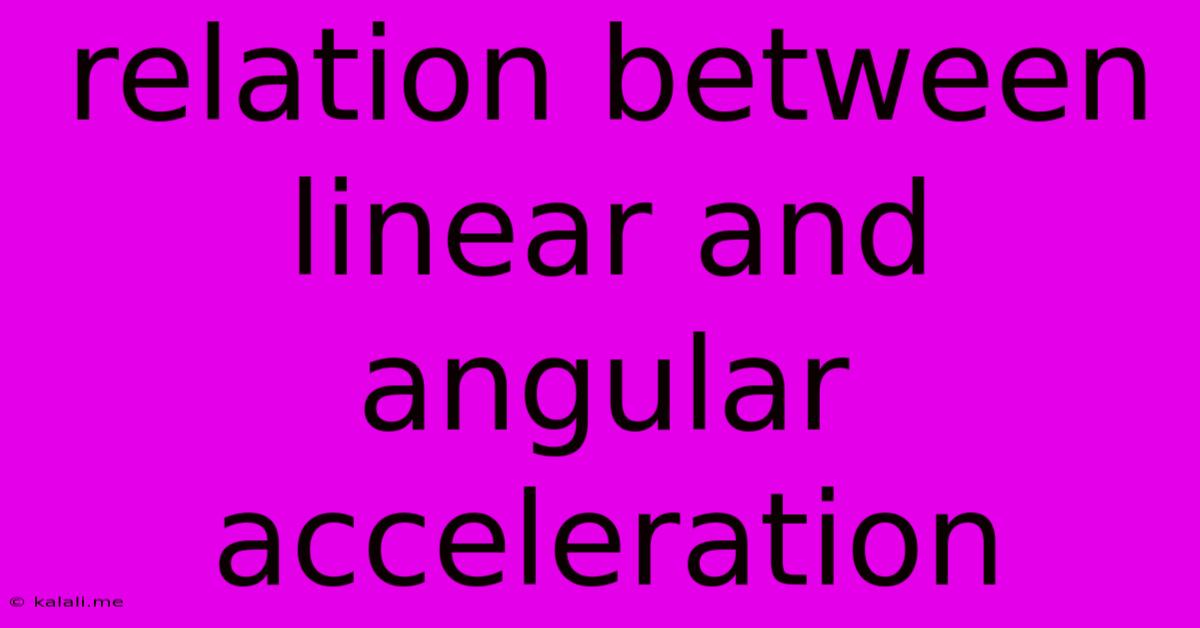Relation Between Linear And Angular Acceleration
Kalali
Jun 16, 2025 · 3 min read

Table of Contents
The Intertwined Dance of Linear and Angular Acceleration: A Comprehensive Guide
Understanding the relationship between linear and angular acceleration is crucial for comprehending rotational motion in physics and engineering. This article will explore this connection, providing a clear explanation suitable for students and enthusiasts alike. We'll delve into the definitions, formulas, and practical applications of both concepts, emphasizing their interconnectedness.
Linear acceleration describes the rate of change of an object's linear velocity. It tells us how quickly the object's speed and direction are changing along a straight line or a curved path. Angular acceleration, on the other hand, describes the rate of change of an object's angular velocity. It tells us how quickly the object's rotational speed is changing around a fixed axis of rotation. While seemingly distinct, these two accelerations are intrinsically linked, particularly when considering the motion of rotating objects.
Defining Linear and Angular Acceleration
Linear acceleration (a) is defined as the change in linear velocity (Δv) over a change in time (Δt):
a = Δv / Δt
Units are typically meters per second squared (m/s²).
Angular acceleration (α) is defined as the change in angular velocity (Δω) over a change in time (Δt):
α = Δω / Δt
Units are typically radians per second squared (rad/s²). Remember that angular velocity (ω) is measured in radians per second (rad/s).
The Connecting Link: Radius
The key to understanding the relationship between linear and angular acceleration lies in the radius (r) of the circular path. Consider a point on a rotating object: as the object rotates, that point traces out a circular path. The radius is the distance from that point to the axis of rotation.
The connection is expressed through these important equations:
- v = ωr: Linear velocity (v) is the product of angular velocity (ω) and radius (r).
- a = αr: Linear acceleration (a) is the product of angular acceleration (α) and radius (r). This equation holds true only for tangential linear acceleration, the component of linear acceleration that's tangent to the circular path. There's also a radial or centripetal acceleration, which we'll discuss later.
Tangential and Radial Acceleration
When an object undergoes circular motion, it experiences two types of acceleration:
-
Tangential Acceleration (a<sub>t</sub>): This is the component of linear acceleration responsible for changing the speed of the object along its circular path. It's directly related to angular acceleration: a<sub>t</sub> = αr.
-
Radial/Centripetal Acceleration (a<sub>c</sub>): This is the component of linear acceleration responsible for changing the direction of the object's velocity, keeping it moving in a circle. It's always directed towards the center of the circle and is given by: a<sub>c</sub> = v²/r = ω²r. Note that radial acceleration is independent of angular acceleration; a constant angular velocity still results in centripetal acceleration.
Combining Accelerations: Resultant Linear Acceleration
The total linear acceleration (a) of a point on a rotating object is the vector sum of its tangential and radial accelerations:
a = √(a<sub>t</sub>² + a<sub>c</sub>²)
This resultant acceleration represents the overall change in both speed and direction of the object's linear velocity.
Real-World Applications
The relationship between linear and angular acceleration is fundamental to many fields:
- Mechanical Engineering: Designing rotating machinery, analyzing the forces on gears, and predicting the motion of robotic arms.
- Automotive Engineering: Understanding tire dynamics, vehicle stability control systems, and the performance of rotating components in engines.
- Aerospace Engineering: Analyzing the motion of spinning satellites, designing aircraft propellers, and understanding the dynamics of rotating spacecraft components.
- Physics: Studying the motion of planets, analyzing the behavior of rotating rigid bodies, and understanding the concepts of torque and moment of inertia.
Understanding the interconnectedness of linear and angular acceleration provides a crucial foundation for analyzing and predicting the motion of rotating systems. By mastering these concepts and their associated formulas, you'll gain a deeper insight into the mechanics of the rotational world around us.
Latest Posts
Latest Posts
-
How To Create Clickable Image In Html
Jun 16, 2025
-
What Are The Factors Of 121
Jun 16, 2025
-
What Is A Theme Of The Passage
Jun 16, 2025
-
A Company That Provides Access To The Internet
Jun 16, 2025
-
Which Word Is Closest In Meaning To The Underlined Word
Jun 16, 2025
Related Post
Thank you for visiting our website which covers about Relation Between Linear And Angular Acceleration . We hope the information provided has been useful to you. Feel free to contact us if you have any questions or need further assistance. See you next time and don't miss to bookmark.